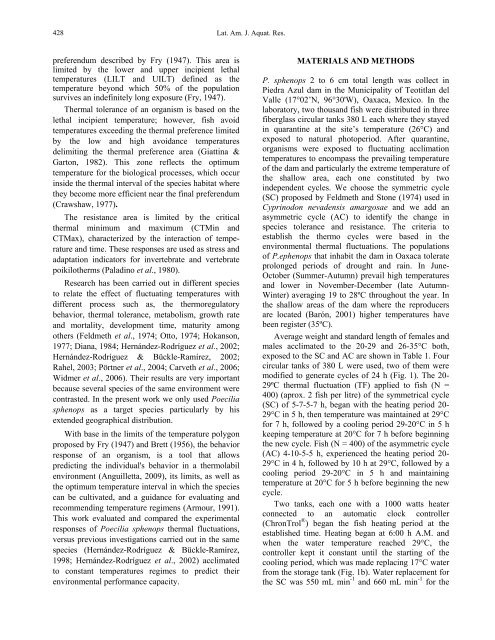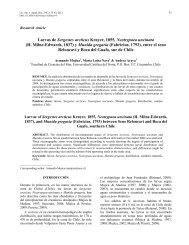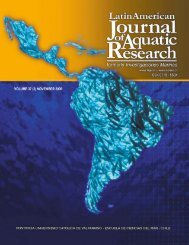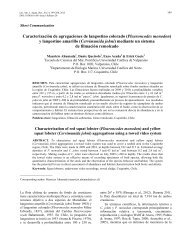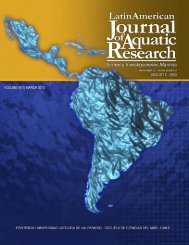Portada LAJAR.psd - Latin American Journal of Aquatic Research
Portada LAJAR.psd - Latin American Journal of Aquatic Research
Portada LAJAR.psd - Latin American Journal of Aquatic Research
Create successful ePaper yourself
Turn your PDF publications into a flip-book with our unique Google optimized e-Paper software.
428<br />
preferendum described by Fry (1947). This area is<br />
limited by the lower and upper incipient lethal<br />
temperatures (LILT and UILT) defined as the<br />
temperature beyond which 50% <strong>of</strong> the population<br />
survives an indefinitely long exposure (Fry, 1947).<br />
Thermal tolerance <strong>of</strong> an organism is based on the<br />
lethal incipient temperature; however, fish avoid<br />
temperatures exceeding the thermal preference limited<br />
by the low and high avoidance temperatures<br />
delimiting the thermal preference area (Giattina &<br />
Garton, 1982). This zone reflects the optimum<br />
temperature for the biological processes, which occur<br />
inside the thermal interval <strong>of</strong> the species habitat where<br />
they become more efficient near the final preferendum<br />
(Crawshaw, 1977).<br />
The resistance area is limited by the critical<br />
thermal minimum and maximum (CTMin and<br />
CTMax), characterized by the interaction <strong>of</strong> temperature<br />
and time. These responses are used as stress and<br />
adaptation indicators for invertebrate and vertebrate<br />
poikilotherms (Paladino et al., 1980).<br />
<strong>Research</strong> has been carried out in different species<br />
to relate the effect <strong>of</strong> fluctuating temperatures with<br />
different process such as, the thermoregulatory<br />
behavior, thermal tolerance, metabolism, growth rate<br />
and mortality, development time, maturity among<br />
others (Feldmeth et al., 1974; Otto, 1974; Hokanson,<br />
1977; Diana, 1984; Hernández-Rodríguez et al., 2002;<br />
Hernández-Rodríguez & Bückle-Ramírez, 2002;<br />
Rahel, 2003; Pörtner et al., 2004; Carveth et al., 2006;<br />
Widmer et al., 2006). Their results are very important<br />
because several species <strong>of</strong> the same environment were<br />
contrasted. In the present work we only used Poecilia<br />
sphenops as a target species particularly by his<br />
extended geographical distribution.<br />
With base in the limits <strong>of</strong> the temperature polygon<br />
proposed by Fry (1947) and Brett (1956), the behavior<br />
response <strong>of</strong> an organism, is a tool that allows<br />
predicting the individual's behavior in a thermolabil<br />
environment (Anguilletta, 2009), its limits, as well as<br />
the optimum temperature interval in which the species<br />
can be cultivated, and a guidance for evaluating and<br />
recommending temperature regimens (Armour, 1991).<br />
This work evaluated and compared the experimental<br />
responses <strong>of</strong> Poecilia sphenops thermal fluctuations,<br />
versus previous investigations carried out in the same<br />
species (Hernández-Rodríguez & Bückle-Ramírez,<br />
1998; Hernández-Rodríguez et al., 2002) acclimated<br />
to constant temperatures regimes to predict their<br />
environmental performance capacity.<br />
Lat. Am. J. Aquat. Res.<br />
MATERIALS AND METHODS<br />
P. sphenops 2 to 6 cm total length was collect in<br />
Piedra Azul dam in the Municipality <strong>of</strong> Teotitlan del<br />
Valle (17°02’N, 96°30'W), Oaxaca, Mexico. In the<br />
laboratory, two thousand fish were distributed in three<br />
fiberglass circular tanks 380 L each where they stayed<br />
in quarantine at the site’s temperature (26°C) and<br />
exposed to natural photoperiod. After quarantine,<br />
organisms were exposed to fluctuating acclimation<br />
temperatures to encompass the prevailing temperature<br />
<strong>of</strong> the dam and particularly the extreme temperature <strong>of</strong><br />
the shallow area, each one constituted by two<br />
independent cycles. We choose the symmetric cycle<br />
(SC) proposed by Feldmeth and Stone (1974) used in<br />
Cyprinodon nevadensis amargosae and we add an<br />
asymmetric cycle (AC) to identify the change in<br />
species tolerance and resistance. The criteria to<br />
establish the thermo cycles were based in the<br />
environmental thermal fluctuations. The populations<br />
<strong>of</strong> P.ephenops that inhabit the dam in Oaxaca tolerate<br />
prolonged periods <strong>of</strong> drought and rain. In June-<br />
October (Summer-Autumn) prevail high temperatures<br />
and lower in November-December (late Autumn-<br />
Winter) averaging 19 to 28ºC throughout the year. In<br />
the shallow areas <strong>of</strong> the dam where the reproducers<br />
are located (Barón, 2001) higher temperatures have<br />
been register (35ºC).<br />
Average weight and standard length <strong>of</strong> females and<br />
males acclimated to the 20-29 and 26-35°C both,<br />
exposed to the SC and AC are shown in Table 1. Four<br />
circular tanks <strong>of</strong> 380 L were used, two <strong>of</strong> them were<br />
modified to generate cycles <strong>of</strong> 24 h (Fig. 1). The 20-<br />
29ºC thermal fluctuation (TF) applied to fish (N =<br />
400) (aprox. 2 fish per litre) <strong>of</strong> the symmetrical cycle<br />
(SC) <strong>of</strong> 5-7-5-7 h, began with the heating period 20-<br />
29°C in 5 h, then temperature was maintained at 29°C<br />
for 7 h, followed by a cooling period 29-20°C in 5 h<br />
keeping temperature at 20°C for 7 h before beginning<br />
the new cycle. Fish (N = 400) <strong>of</strong> the asymmetric cycle<br />
(AC) 4-10-5-5 h, experienced the heating period 20-<br />
29°C in 4 h, followed by 10 h at 29°C, followed by a<br />
cooling period 29-20°C in 5 h and maintaining<br />
temperature at 20°C for 5 h before beginning the new<br />
cycle.<br />
Two tanks, each one with a 1000 watts heater<br />
connected to an automatic clock controller<br />
(ChronTrol ® ) began the fish heating period at the<br />
established time. Heating began at 6:00 h A.M. and<br />
when the water temperature reached 29°C, the<br />
controller kept it constant until the starting <strong>of</strong> the<br />
cooling period, which was made replacing 17°C water<br />
from the storage tank (Fig. 1b). Water replacement for<br />
the SC was 550 mL min -1 and 660 mL min -1 for the


